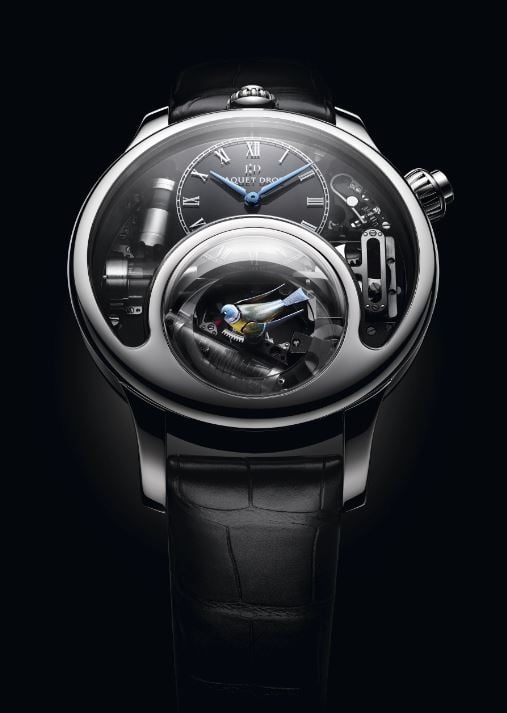Art World
Jaquet Droz’s Birds of Paradise Take Watchmaking to New Artistic Heights
It is as much an experience as it is a timepiece.

It is as much an experience as it is a timepiece.

Artnet News

The conflicting spirits of the ages of Reason and Romanticism coexist beautifully in Jacquet Droz’s Charming Bird watch. As with many examples of the exquisite watches produced by the venerable Swiss company, science does not trump nature or innovation outflank tradition: they work in perfect harmony.
The Charming Bird, a sapphire-dial watch encased in 18-carat red or white gold (and limited to 28 in each style), is as much an experience as it is a timepiece: a beguilingly mechanical art spectacle worn on the wrist that, strange as it seems, gives a perfect answer to the question, “Where is he that giddy sprite/Blue-cap, with his colors bright…?” It was posed, in “The Kitten and Falling Leaves” (1804), by the Romantic poet William Wordsworth, who went on to reflect on the blue-cap’s—or blue-tit’s—habit of feeding in apple trees, where he:
Made such wanton spoil and rout,
Turning blossoms inside out,
Hung with head towards the ground,
Flutter’d, perch’d; into a round
Bound himself, and then unbound;
Lithest, gaudiest Harlequin,
Prettiest Tumbler ever seen,
Light of heart, and light of limb.
What is now become of Him?”
One place Wordsworth’s tumbling blue-tit ended up is inside the tiny dome on the face of the Charming Bird watch. A feathered mini-figurine perched above a miniature steel metropolis of cogs, camshafts, wheels, bellows, and springs, he juts out his yellow breast and, gently flapping his wings of black and blue plumage, spins back and forth whistling his tune on push-button command—the first horological automaton of its kind. He is a glorious contradiction: a one-bird industrial revolution in thrall to the miracle of nature. (The cam-style actually originated in Age of Enlightenment mechanical engineering.)

Setting aside the advanced skills that enabled Jacquet Droz’s master technicians, craftsmen, and enamellers to create such a fusion of precision engineering and natural simulation, it’s worth asking why the blue-tit demanded pride of place in his little domicile on the Charming Bird watch and why his trills and movements resonate with Jaquet Droz’s 277-year history.
One has to look beyond the Eurasian blue-tit as a folkloric symbol of happiness, completion, and romantic fidelity (not that blue tits are truly monogamous); as a seldom-straying bird that brings good tidings to sailors returning home; as an envoy that carries the spirits of sailors lost at sea to heaven. The Charming Bird—2015’s winner of the Mechanical Exception Watch Prize at the Grand Prix d’Horlogerie de Genève—is doubly an homage to Jaquet Droz’s past.

In the first instance, the image of the blue-tit connotes the bucolic upbringing of Pierre Jaquet-Droz (1721-90), the virtuoso Swiss watchmaker and founder of the unique brand. Born and raised in La Chaux-de-Fonds (also the birthplace of Le Corbusier) in the canton of Neuchâtel, Pierre was a child of the Jura Mountains, a habitué of the Doubs Falls, the serpentine Lac des Brenets on the French border, and the local woods and streams. He doubtless glimpsed bears, foxes, wolves, kites, and ravens. We know from the intricate horological bird cages Pierre created that he esteemed the region’s songbirds and would have been especially familiar with the whistles and cavortings of the blue-tit, which is indigenous to Jura, Mittelland, Ticino, and the Rhine and Rhône valleys. The Charming Bird celebrates Pierre’s love of the blue, yellow, and black mischief-maker, a spirit as blithe to him and Wordsworth as the skylark was to Percy Bysshe Shelley.
As an automaton, the Charming Bird also pays tribute to the three programmed marvels that Pierre, a marketing visionary, built to advertise Jaquet-Droz’s wares. Constructed with the help of his partner Jean-Frédéric Leschot (1746-1824), and his son Henri-Louis (1752-91), the female android known as “The Musician” (2,500 parts) and her male siblings “The Writer” (6,000 parts) and “The Musician” (2,500 parts), each of whom performs a task comparatively simple for a professionally talented flesh-and-blood human but mind-bogglingly intricate for a mechanical one. Forerunners of the computer, they were joined in 2012, by a new Jaquet-Droz automaton—an 18th-century magician who’s amazed to find that a chirruping, semi-spinning, wing-beating blue-tit has appeared under one of the bells he gently lifts from a table, and even so more so when it magically reappears under the other bell!
Fortunately, the blue-tit inside the Charming Bird doesn’t disappear at all. Nor do the automated whistling blue-tits inside Jaquet-Droz’s 2012 Bird Repeater watch—the parents perched on opposite ends of a nest (the father fanning his feathers) and their two oldest chicks inside it, one of which cranes toward their mother’s beak, only to be upstaged by the newborn who cracks the egg lying between them and pops its head up.
Pierre himself would have been delighted by the antics of the feathery friends inside Jaquet-Droz’s 21st century watches, which continue the company’s tradition of bringing a timeless quality to the art of telling the time.